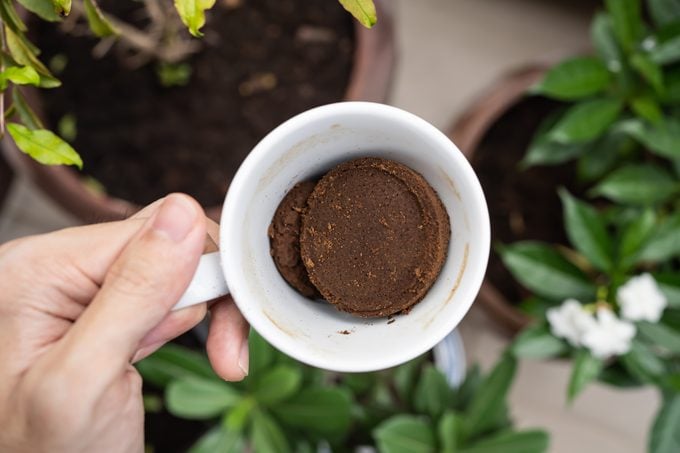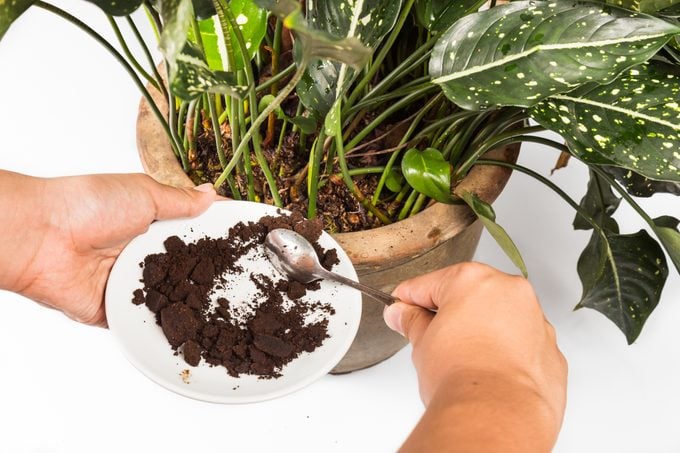4 Ways to Use Coffee Grounds in the Garden
Updated: Apr. 25, 2023
Perk up your plants! Learn how an expert says gardeners should use their leftover coffee grounds.

Once you’ve enjoyed your morning brew, consider putting the coffee grounds in your garden. These four ideas for recycling coffee grounds keep a valuable resource out of the landfill—and your precious plants will reap the benefits.
1. Add Coffee Grounds to Compost
Dump the daily discards—both the paper filter and the grounds—right into your compost pile, but be sure they’re cooled off. The microorganisms in the compost will help turn them into a rich soil amendment. Moderation is important when composting coffee grounds. Your pile should contain no more than 20% grounds in the overall volume. Once decomposed, the coffee-rich compost is ready for use in your gardens and containers.
2. Use Coffee Grounds as Mulch
Cooled fresh coffee grounds can be used as a mulch too. Spread a layer 1/2 inch or thinner over the soil surface. The grounds’ fine texture makes them prone to compaction, which may prevent water from penetrating the soil below. To avoid this, consider covering them with another thicker layer of coarse mulch to minimize compression.
Discover 7 uses for eggshells in the garden.
3. Improve or Slow Drainage in Soil
Work fresh grounds into the soil the way you would with other organic matter to improve the water-holding ability of sandy soils or the drainage in heavy clay soils. It won’t lower your soil pH, but adding fresh grounds directly to the soil has a short-term impact on plant growth. As the microorganisms break down the grounds, they temporarily tie up the nitrogen in the soil. This may result in yellowing and stunting of leaves. Consider adding nitrogen fertilizer or incorporating the grounds along with nitrogen-rich plant debris in fall. These break down over winter and improve the soil for spring planting.
Learn how to test your soil pH and texture at home.
4. Use Coffee as a Natural Pest Control
You may have heard or read that coffee grounds repel slugs and snails. The University of Hawaii found that dilute solutions of caffeine repelled or killed slugs and snails. It’s still up for debate whether that translates to using coffee grounds on the soil around plants to accomplish the same. However, it’s worth a try, but know that you should still monitor and manage slugs and snails as needed.
Here’s how to get rid of the worst garden pests.
Should You Use Coffee Grounds as Fertilizer?

“Can I spread coffee grounds at the bases of trees and shrubs to add nitrogen to the soil?” asks Ken Long of Middletown, Ohio.
Coffee grounds can successfully be used in indoor and outdoor gardens, but moderation is key. Be selective and avoid applying large quantities of fresh grounds to the soil. This can temporarily tie up soil nutrients. Plus, coffee contains allelopathic chemicals that inhibit the growth of certain plants. Avoid using coffee grounds around seedlings, tomatoes in particular.
Unfortunately, there is no comprehensive list of plants that thrive or decline in coffee-amended soil. Once the grounds are fully decomposed, however, there is no need for concern.
The best place for coffee grounds is the compost pile. Composting grounds as a first step eliminates both issues while allowing you to recycle your morning grounds into a wonderful soil amendment.
Psst—we found 6 genius garden hacks you’ll want to steal immediately.
Bonus Tip: DIY Hand Scrub
Set aside some coffee grounds to make a homemade hand scrub. Combine the grounds with water and coconut oil, and apply to the skin. The grit of the grounds removes dirt, while the coconut oil softens skin, especially after a day in the garden.
Next, learn what foods to feed birds from the kitchen.




















